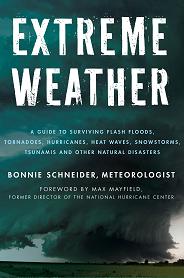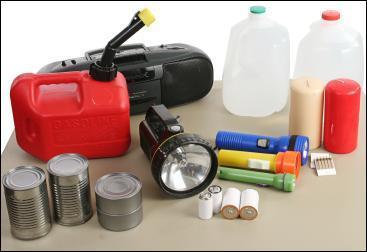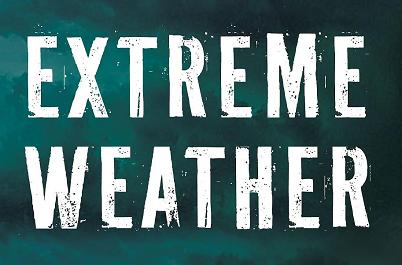 By anyone’s measure, the weather has become increasingly extreme in recent years. Whether it’s hurricanes on the coasts, tornadoes in the Midwest or wildfires, landslides and mudslides in the west—Mother Nature has a way of letting us know she’s in charge.
By anyone’s measure, the weather has become increasingly extreme in recent years. Whether it’s hurricanes on the coasts, tornadoes in the Midwest or wildfires, landslides and mudslides in the west—Mother Nature has a way of letting us know she’s in charge.
Naturally everyone says to “be prepared,” but what exactly that means isn’t always obvious and can change depending on the scenario.
Sure, the authorities always say to stock up on batteries and have some food and water on hand, but a disaster plan should be something more than standing in line at Home Depot or heading for the hills.
Meteorologist Bonnie Schneider offers a detailed disaster-planning guide in her book “Extreme Weather.” Schneider, who has appeared on CNN and HLN, offers insights into surviving flash floods, tornadoes, hurricanes, heat waves, snowstorms, tsunamis and other natural disasters.
“There’s definitely a lot more extremes in weather, 2011 was a record year for natural disasters, over 500 people were killed in tornadoes alone and over a thousand were killed in total,” Schneider says. “If you look at 2012 this wasn’t a year epically for tornadoes per se but it was a record year for drought. It was also a record year for wildfires so I think you might not have the same type of disaster every year but you are seeing more extremes in weather.”
She says in recent years disasters are also striking areas where they typically have an unexpected—such as a major tornado in Tuscaloosa, Ala. in 2011 or the twisters that hit New York in September. The “frankenstorm” of Hurricane Sandy is another.
Schneider’s book offers a chapter on each type of disaster, including personal stories from those who survived them—such as hurricane Katrina in 2005 and the 2004 tsunami that hit Southeast Asia.
“I talk about what causes the different types of weather phenomenon such as what causes a tornado and then what to do whether you’re at home or at work, what kind of supplies you should have at home. There’s also information in each chapter on how to take care of your pets,” Schneider says. “I have a checklist in the book that you can go through your house or place of business and see what you’re missing to make sure you’re stocked up.”
Staying connected
Overall, she says it’s a good idea for everyone, regardless of what kind of disaster they could face, to have a family response plan that specifies what each person’s role would be in an emergency.
Communication can be difficult but crucial in an emergency, so Schneider recommends having an out-of-town friend or relative established as a central point of contact for everyone to reach, just in case the cell phone networks go down. In an age when many people have more than one email account and may or may not be checking a Facebook page, a family plan should identify the best way of getting in touch.
“It’s mostly about communication, making sure everyone in the family knows how to reach each other in an emergency because sometimes the kids could be at school, the parents could be at work and everyone should have a way of reaching each other,” Schneider says.
 In an era when people rely on electronic directories, Schneider says it’s important to memorize the cell phone number of every family member and make sure everyone knows how to text.
In an era when people rely on electronic directories, Schneider says it’s important to memorize the cell phone number of every family member and make sure everyone knows how to text.
There have been many disasters where cell phone service was disrupted and busy at the same time, leaving texts as the only way for people to communicate. In an emergency, there needs to be a game plan in place with everyone knowing what to do.
“My message is really to be aware of any potential threat and be aware of what the forecast is, have your supplies ready and communicate with your family. That’s so important,” Schneider says. “You have to know how to reach people and everyone needs to know what to do and practice it, practice it in your place of business, practice it in your family and say this is how we exit the house, this is how we get out, this is where we go.”
As part of basic survival gear, Schneider says a National Oceanic Atmospheric Administration weather radio is crucial, as it can sound an alert in case of tornadoes or major storms.
Families should also have a three-day supply of food and water for each person and their pets—which can often be neglected during a crisis if their owners forget to plan for how they’ll take care of them. Anyone with prescriptions should make sure they have enough to get by.
On the road
In the car it’s important to have blankets, a flashlight, water and some kind of food source such as a protein bar. Other essentials include flares and a can of fix a flat, which can seal a punctured tire and fill it with enough air to get by.
There are also emergency cell phones available with batteries that can hold a charge for several years in the glove compartment yet still provide enough talk time to call for help.
Schneider recommends something to break open a window and cut a seatbelt with in case of a water and car mishap, such as a flash flood. A product called a Lifehammer, for example, attaches to a keychain and can be used to shatter a car window in case the vehicle is submerged and water pressure prevents the door from being opened.
“Most deaths from flooding occur when people are in cars, in vehicles,” Schneider says. “You want to make sure God forbid if this happens to you because from what I found out in my book is that most people were caught off guard, they didn’t know there was a risk of flooding, they didn’t know there was going to be a snowstorm”
Securing the home
Planning for an emergency at home obviously depends on what kind of disasters might come. Preparing a home for major winds, a hurricane or tornado should start with clearing the yard and surrounding area of debris, toys and tools—anything that could become a projectile and slam into the house.
For an attached garage, Schneider says securing that garage door is crucial. Specially-designed brackets can be added to help keep the door in place.
“When it comes to wind damage the biggest point of entry for a home is the garage door so it’s important to put extra bracketing and just to secure the garage door as much is possible because the wind will just shatter that garage door and then the wind comes into the house and then the roof comes off,” Schneider says.
In case of flooding, from any source, Schneider says there are many simple steps people can take to alleviate potential damage such as taping the drapes up high to keep them from getting wet. Appliances should be unplugged and anything that can be moved should be put on the highest floor of the house or put in an out of reach spot, such as on top of the refrigerator.
Anyone at risk of wildfires should clear brush from within a foot circle of the home. She says hosing down a house when a wildfire threatens probably won’t provide much help, but couldn’t hurt either.
 What is important is to be packed up and ready to roll at a minute’s notice—because that’s often how much time someone has to react. Wildfires can change direction without warning and embers can take to the air and spread fire to where it’s not expected.
What is important is to be packed up and ready to roll at a minute’s notice—because that’s often how much time someone has to react. Wildfires can change direction without warning and embers can take to the air and spread fire to where it’s not expected.
“What happens with wildfires is often you’ll get a knock at the door and you have to leave right now, so that’s why the family disaster plan is so important,” Schneider says. “People I interviewed for this book were in Malibu California in 2007 and the knock came and the sheriff or whoever came to the door and said you have to go.”
The need for quick action also arises in case of tornadoes. For her book, Schneider interviewed a woman who survived a 2010 tornado in Yazoo City Miss. by having a NOAA radio with her at work, the woman heard the alert and herded employees and customers into the back room of a department store right just in time.
“She heard the meteorologist warning that was 5 miles away and to take cover,” Schneider says. “She shut down the store and took everyone into the back room. The tornado decimated the whole front of the store, all the glass was gone so she was listening in to cover and because of that saved lives, so it’s very important to be aware.”
Of course, storms don’t always act in ways that are highly predictable and even a glancing blow can wreak havoc on a community. When Hurricane Isaac hit New Orleans it dropped 20 inches of rain. By the time it hit Florida Isaac had been downgraded to a tropical storm, yet still flooded some areas with 17 inches of rain.
Hurricanes, floods and tsunamis
Schnieder recommends securing the garage door ahead of time and installing hurricane shutters over windows, as well as having flood insurance. Floods are not covered under regular homeowners insurance.
Taking pictures and videos of belongings before a storm hits can help define a claim afterwards, with the information saved on a hard drive in a waterproof container or at another location, just in case.
Schneider says having an evacuation plan and obeying evacuation orders are important, and people should keep in mind that “it can’t happen here” is not the right attitude to have in a coastal area and it’s better to play it safe.
Many people in the New York area thought a hurricane wouldn’t strike them, but Tropical Storm Irene 2011 proved otherwise. Hurricane Sandy’s wrath provided another reminder.
Although California is known for its earthquakes, they can actually happen in many places throughout the U.S. When one strikes, Schneider suggests getting under a sturdy piece of furniture rather than fleeing a shaking building, as people have been injured from debris falling off of buildings onto the street.
Based on Schneider’s research she says standing in a door frame, while certainly not a bad idea, wouldn’t be her first choice as furniture is likely to provide better protection.
Tsunamis have the image of being a giant wall of water rushing on shore, which isn’t exactly the full picture. Schneider says they’re actually prolonged events with multiple waves coming ashore, pulling everything out to sea and rushing back again.
After that initial first wave, the second and third strikes could be even stronger. Tsunamis can also move at 500 mph so there might not be much time to react.
“You can’t outrun it, you can’t say I’m going to stay on the beach until it comes and then run away, that’s impossible. You want to head to the highest ground,” Schneider says. “It’s important to know it in any hotel, especially if you’re out of the country where the exits are and how you would evacuate if you had to.”












